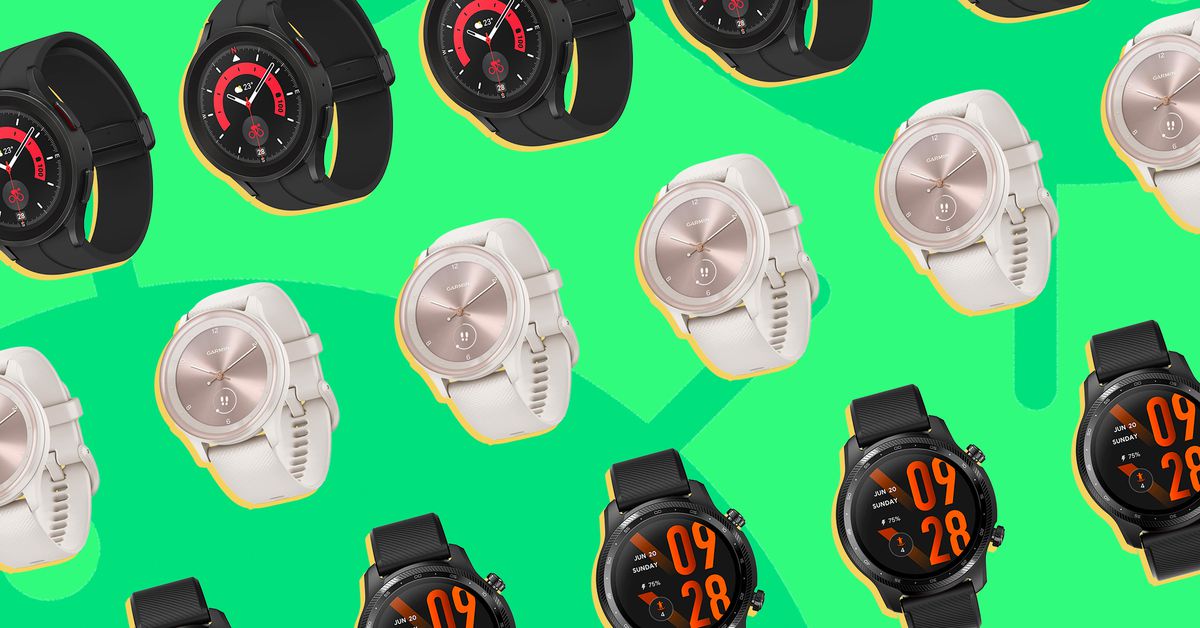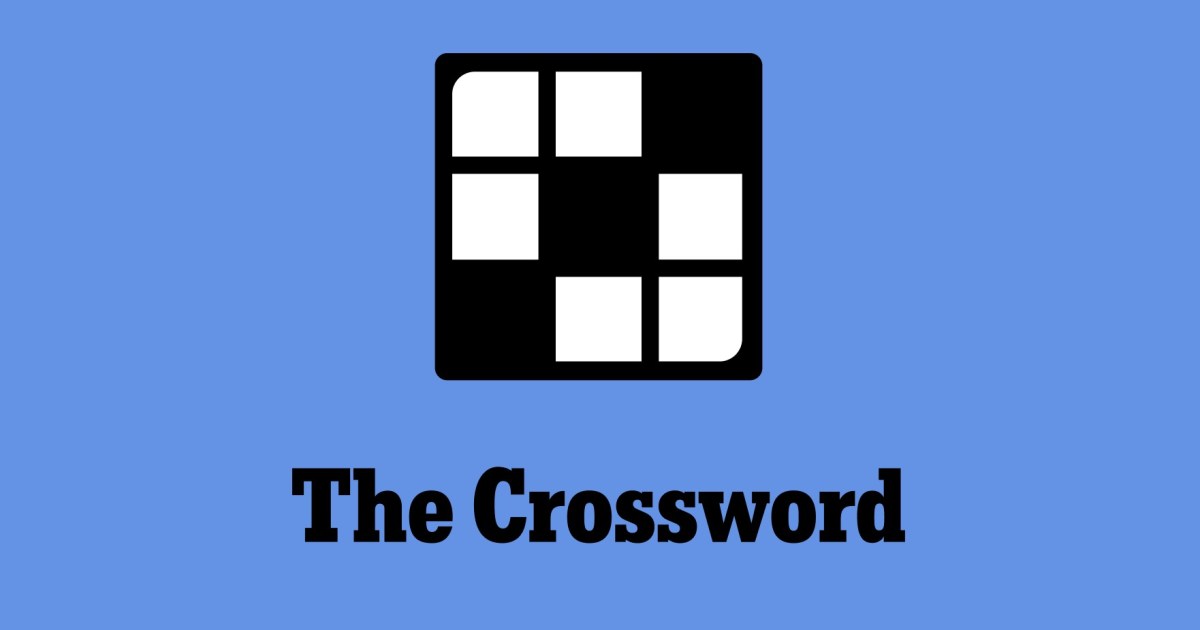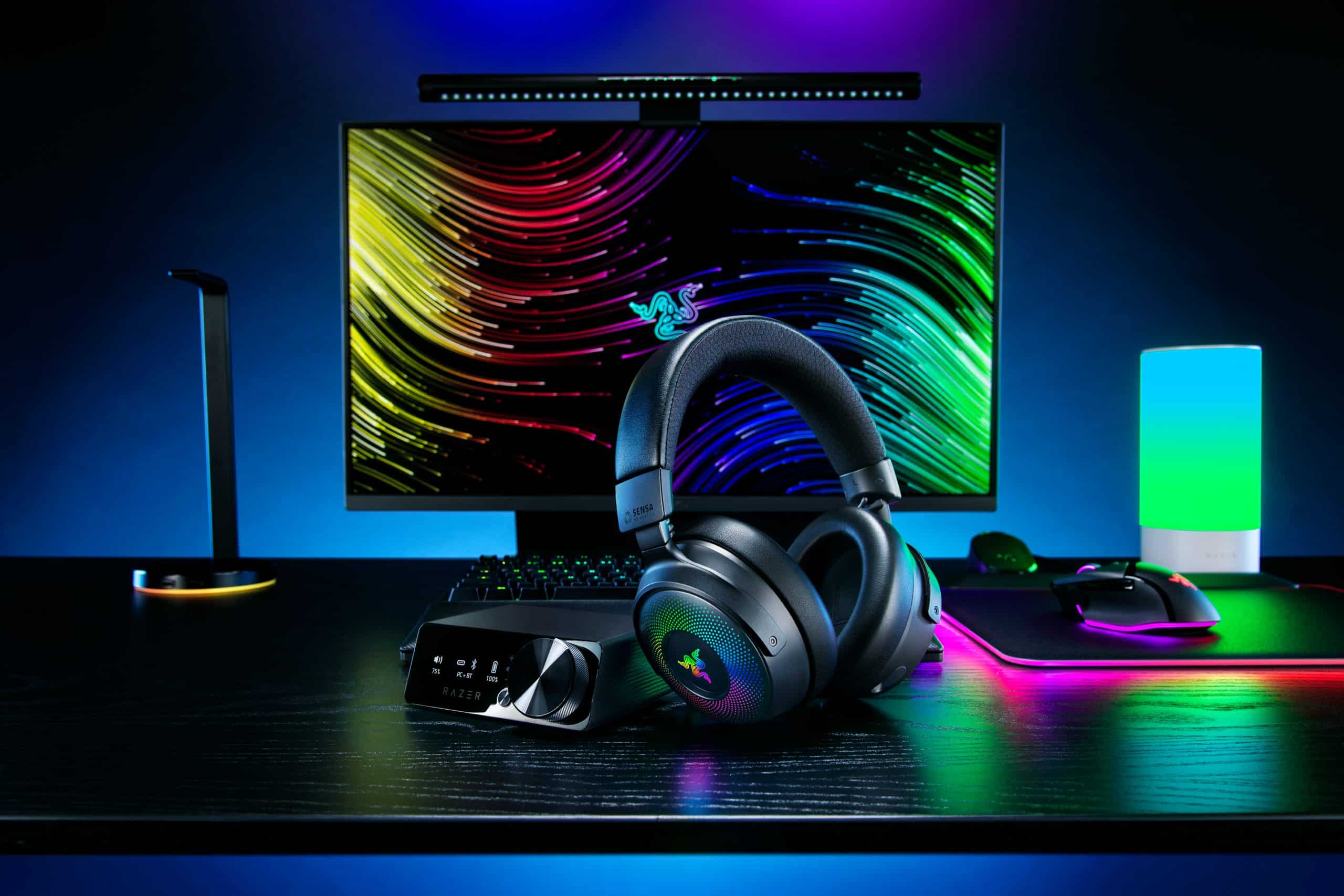Writer’s note: Amazon’s next Prime Day event is officially scheduled for October 8th and 9th. We’ve already assembled a collection of the best early Prime Day deals for those who want to shop ahead, but keep in mind that expect steeper smartwatch savings during the event.
Technology
The seven best Android smartwatches in 2024

After a long stretch of slim pickings, the last couple of years have been huge for Android smartwatches. Now there are more good options than ever.
But this is still a transitional era. While we’re encouraged by the stronger third-party app options, the market is still fragmented. Wear OS 5 is here for Samsung’s Galaxy Watches and the Pixel Watch 3. However, the larger ecosystem is still catching up. Some features, like Google Assistant, are not yet available on certain Wear OS 3 smartwatches, and Wear OS 4 still isn’t widely available. Even so, the Android wearable ecosystem is barreling ahead.
If you’d rather wait until Wear OS settles down a bit, there are platform-agnostic smartwatches and fitness watches you can buy in the meantime. Otherwise, you’ll want to be aware of the chip and Wear OS version powering your watch. Mobvoi, for instance, took forever rolling out Wear OS 3 to its eligible Wear OS 2 watches. It just announced rollout for Wear OS 4. Speaking of Mobvoi, its TicWatch Pro 5 was the first to sport the new Qualcomm Snapdragon W5 Plus in the US, and while it’s a great watch, you may want to wait until there are more W5 Plus watches to choose from. That said, the base W5 chip is also pretty good. The Pixel Watch 3 and OnePlus Watch 2 both sport the W5 and have notably better performance and battery life.
So long as you keep the aforementioned caveats in mind, Android users have more smartwatch options than ever before. I’ve rounded up my top picks, but if none of these is the right fit, you can always check out our fitness tracker buying guide.
Best smartwatch for Samsung phones
Sizes: 43mm, 47mm / Weight: 77g, 85g / Battery life: Up to 30 hours with AOD, 40 without AOD / Display type: Always-on OLED / GPS: Built-in GPS / Connectivity: LTE (optional), Bluetooth, Wi-Fi / Water resistance: Up to 50 meters, IP68 / Music storage: 16GB
If you have a Samsung phone, you’ll get the most mileage out of a Samsung smartwatch. And of the four watches Samsung has in its current lineup, I recommend the Samsung Galaxy Watch 6 Classic. Although Samsung just released the Galaxy Watch 7, there wasn’t a refresh for the Classic. That means you ought to be seeing some good deals for the Classic soon, if not already. It’s not often that I recommend a last-gen device, but such is my deep love for the physical rotating bezel.
But, if you want the latest and greatest, the Galaxy Watch 7 offers an upgraded 3nm Exynos W1000 chip and a new 3-in-1 BioActive Sensor. It’s a marginal improvement over last year’s models, but I don’t feel like Samsung introduced anything this year that requires having them. It also has Wear OS 5 and One UI 6 Watch, but that’ll eventually make its way back to the older watches, too. Mostly, I recommend the 7 if you prefer a smaller size, don’t care about the rotating bezel, and want something a smidge more futureproof.
The Classic’s rotating bezel is 15 percent thinner than the Galaxy Watch 4 Classic. The updated design is sleeker than its predecessor, and the larger display is easier on the eyes and is only slightly bigger at 43mm and 47mm. I have small wrists, but the 47mm was still quite comfortable for everyday wear. It’s launching with Wear OS 4, which adds extended battery life, and — finally — cloud backups. One UI 5 Watch also adds some minor health and sleep tracking improvements, but this will eventually make its way to older models. While I prefer the Classic, the base Watch 6 model may be the better option if you want a smaller, lighter, sleeker, and cheaper smartwatch.
For more outdoorsy folks, the $649.99 Galaxy Watch Ultra might be the more sensible choice. Of all Samsung’s watches, it has the best battery life, lasting around three days in our testing. (Though, we never got the full 100-hour estimated battery life.) It’s got dual-frequency GPS, a new multisport activity, an emergency siren, increased durability, 10ATM of water resistance, and a Quick Button, which acts as a customizable shortcut button. It’s basically an Apple Watch Ultra for Android.
Meanwhile, if you’re on a budget, there’s the new $199.99 Galaxy Watch FE, which is essentially a rebadged Galaxy Watch 4.
The Samsung Health app also delivers a good overall fitness tracking experience, especially since you can enable turn-by-turn navigation for hiking and cycling activities. We weren’t too impressed with nightly SpO2 readings, but Samsung’s overall sleep tracking continues to improve. You also get built-in GPS, body composition analysis, irregular heart rate notifications, fall detection, emergency SOS features, and EKGs. Most recently, Samsung’s added a new Energy score, AI-powered wellness insights, FDA-cleared sleep apnea detection, and a confusing AGEs Index metric for metabolic health. While the Energy score is broadly accurate, I found the AI-generated features to be hit or miss and the AGEs Index to be more gimmicky than useful. The latter feature is also limited to the Galaxy Watch 7 and Ultra.
We don’t necessarily recommend the Galaxy Watches if you don’t have a Samsung phone. EKGs and sleep apnea detection require the Samsung Health Monitor app, which is limited to Samsung phones. You can work around it, but all Samsung watches work best with other Samsung devices.
Best Android smartwatch for non-Samsung users
Sizes: 41mm, 45mm / Weight: 31g for 41mm, 37g for 45mm / Battery life: Roughly 24 hours with AOD enabled / Display type: Always-on OLED / GPS: Built-in GPS / Connectivity: LTE (optional), Bluetooth, Wi-Fi, Safety Signal with Fitbit Premium / Water resistance: 5ATM / Music storage: 32GB
The $349.99 Google Pixel Watch 3 is done playing catch-up. It’s an annoying truth that if you have a Samsung phone, a Samsung smartwatch is probably the best choice for you. However, for everyone else, I highly recommend the Pixel Watch 3.
There are several updates to the Pixel Watch 3, but the gist is that it’s a more refined watch that also expands into new territory. One major update this year is that there are now two sizes: 41mm and 45mm. You get extra screen real estate on the larger watch, but the bezels are also smaller on the 41mm model this year. (If you’re trying to pick between sizes, I prefer the 45mm.) The displays are brighter as well, ranging from a minimum of 1 nit to a maximum of 2,000 nits.
Health and fitness also get several updates, especially for runners. There’s a new Cardio Load metric that gauges the cardiovascular intensity of the exercises you’ve been doing over a set period of time. It’s similar to Garmin’s Training Load metric. You’re also given a Cardio Load target based on your fitness goals, readiness, and current activity. Runners also get a new dashboard full of form analysis metrics as well as the ability to program custom workouts. In addition, you can get AI-generated suggested workouts. And if you’re in Europe, the Pixel Watch 3 can now detect if you no longer have a pulse and call emergency services.
The Pixel Watch 3 also adds a bunch of nifty Google integrations. It’s excellent if you have a Google-powered smart home because you can now directly view and interact with your Nest Doorbell or camera feeds. You can also use the watch as a remote for your Google TV, and there are new Google Home Tile / complications that make controlling your home from your wrist a breeze. Also new this year are offline Google Maps, the ability to unlock Pixel phones, and a Call Assist feature that lets a caller know you need an extra minute to pick up your phone.
That said, while the Pixel Watch was initially framed as a watch for any Android phone, several updates this time around mean you’ll get the best experience with a Pixel phone. But compared to Samsung, there isn’t quite as much lock-in. Health features, for example, are available to everyone so long as you have a Fitbit account. Extra good news: Google removed certain metrics, like the Daily Readiness Score, from the Fitbit Premium paywall. Mostly, the features locked to Pixel phones are things like the ability to unlock your phone with the watch and use of the Recorder app.
One thing to be mindful of is durability. While the domed display is beautiful, we cracked the screen on the original Pixel Watch and got deep scratches on the Pixel Watch 2. (Thankfully, we haven’t messed up the Pixel Watch 3.) Google doesn’t offer any repair options, but you can get the Preferred Care extended warranty if you want to be prepared should something happen. It’s not ideal since it’s limited to the US and Canada, but it’s a step in the right direction.
Best alternative to Google and Samsung smartwatches
Sizes: 47mm with 22mm straps / Weight: 49g case, 80g with strap / Battery life: Up to 100 hours in smart mode, 48 with AOD on, and 12 days in power-saving mode / Display type: OLED touchscreen / GPS: Dual-frequency GPS, Beidou, GPS, Galileo, GLONASS, QZSS / Connectivity: Bluetooth, Wi-Fi / Water resistance: 5ATM / Music storage: 32GB
The $299.99 OnePlus Watch 2 is what a glow-up looks like. While the original OnePlus Watch was horrible, this watch helps fill the void that Fossil left when it said it was pulling out of Android smartwatches — namely, a viable alternative to Google and Samsung.
The 47mm case is big for petite wrists, and unfortunately, it only comes in one size, but it’s made of durable stainless steel and sapphire crystal. Plus, it houses a 500mAh battery. That, plus a dual-chip architecture and novel dual OS system, results in super long battery life. How long a smartwatch lasts will of course depend on your individual usage, but I got nearly four days with normal use. That’s incredible for a flagship.
It also has Wear OS 4, making it the only third-party Wear OS watch running the latest software. It has Google Assistant from the get-go — a big achievement since that’s been a problem with other third-party Android watches. Plus, you get access to the Google Play Store for a robust app ecosystem. On the fitness side of things, OnePlus added dual-frequency GPS. That’s a plus if you’re outdoorsy and frequent challenging GPS environments like dense forests or crowded cities.
The main things you’re giving up are LTE connectivity and some features like EKGs, atrial fibrillation detection, native period tracking, and fall detection. The lack of cellular is a bummer, as it means you really should keep your phone on you when you’re out and about. Still, the $300 price tag is a competitive one and may be worth the tradeoff given battery life.
Best fitness smartwatch for Android
Sizes: 50mm with 24mm straps / Weight: 44.3g / Battery life: Up to 80 hours / Display type: OLED touchscreen and secondary ultra-low power display / GPS: GPS, GLONASS, GALILEO, Beidou / Connectivity: Bluetooth, Wi-Fi / Water resistance: 5ATM / Music storage: 32GB
Mobvoi’s TicWatch lineup has its devoted fans for a reason: super long battery life. The $249.99 TicWatch Pro 5 is no exception. It’s got an estimated 80 hours of battery life with standard use, a secondary ultra-low power display, and a massive (for a smartwatch you wear on your wrist, at least) 628mAh battery. I didn’t quite get 80 hours in my testing, but I did get a solid 48-60 hours even with heavy GPS use. That outclasses most of the watches in this category (except the OnePluS Watch 2) and is useful for backpackers and endurance athletes. It might not hold a candle to a top-of-the-line Garmin, but it’s also a smarter watch for a fraction of the price.
Battery life aside, the Pro 5 is a good option for fitness-focused people who aren’t keen on giving up smart capabilities for a Garmin or Polar. It’s also more durable. This time around, Mobvoi has also added a digital crown so you don’t have to worry about scrolling through menus with sweaty fingers. The flatter side button also reduces the risk of accidental presses.
The Pro 5 also has an ingenious method of displaying heart rate. When you lift up your arm, the backlight changes color depending on which heart rate zone you’re in. That means you can instantly gauge whether to up the intensity or slow your roll. The Pro 5 also adds new training metrics, like VO2 Max and recovery time.
The TicWatch supports stress tracking, all-day blood oxygen monitoring, fatigue assessments, as well as atrial fibrillation and irregular heartbeat detection. For outdoorsy types, it also has access to multiple GNSS systems, and there’s a new barometer and compass app, as well as a one-tap measurement app that gives you a quick look at five metrics (heart rate, blood oxygen, stress, respiratory rate, and overall heart health).
It’s also pretty capable on the productivity front. You get contactless payments, access to the Play Store, notifications, and the ability to take calls. It’s also the only Android smartwatch available in the US with the latest Qualcomm Snapdragon W5 Plus chip, which is a plus in terms of futureproofing. The only major concerns are the 50mm case that may not suit smaller wrists and the lack of a digital assistant.
And good news! Mobvoi just announced that Wear OS 4 is rolling out this month.
Best hybrid smartwatch
Sizes: 37mm with 18mm straps / Weight: 45g / Battery life: Up to 39 days / Display type: OLED display / GPS: Tethered GPS / Connectivity: Bluetooth / Water resistance: 5ATM / Music storage: N/A
Hybrid smartwatches are an excellent way to keep things simple and subtle. The $249.95 Withings ScanWatch Light gets you the basics like push notifications, timers, and alarms. On the health front, you can track steps, sleep, menstrual cycles, and GPS workouts. (That said, GPS is tethered from your phone, not built in.) The design reminds me of a classier Swatch, particularly if you get the more colorful options in a minty green or pale blue. But the big reason the Light has dethroned our previous pick, the Garmin Vivomove Sport, is its extra-long battery life. Withings estimates it lasts up to 30 days on a single charge, and I got pretty close to that in testing with 25 days. Despite the Vivomove’s more appealing $180 price tag, it only lasts about five days.
If you want a bit more out of a hybrid, you can also opt for the ScanWatch 2. It’s an extra $100, but you get EKGs and atrial fibrillation detection, temperature sensors, SpO2 readings, and an altimeter for measuring elevation. It also looks a bit more elegant on the wrist, partly because of a secondary dial that tracks your daily step progress.
If neither matches your style, the Vivomove Sport is still a good option that gets you access to Garmin’s in-depth platform. Its Vivomove Trend is a slightly more upscale option that also supports Qi charging.
Best platform-agnostic fitness smartwatch
Sizes: 41mm with 18mm straps; 45mm with 22mm straps / Weight: 40g for the 3S; 47g for the 3 / Battery life: Up to 10 days for 3S; 14 days for 3 / Display type: OLED touchscreen / GPS: GPS, GLONASS, GALILEO / Connectivity: Bluetooth, Ant Plus, Wi-Fi / Water resistance: 5ATM / Music storage: 8GB
Garmin is best known for making rugged GPS watches that have excellent fitness features but aren’t so smart otherwise. But the $449.99 Venu 3 caters to people who want top-notch fitness tracking without sacrificing productivity features.
It’s got a colorful and vibrant always-on OLED display and comes in two sizes: 41mm and 45mm. Like its predecessor, the Venu 2 Plus, it also has a microphone and speaker so you can take and make calls directly from the wrist. It also has a clever workaround for digital assistants — it uses Bluetooth to work with whatever assistant is already on your phone. You’d think more fitness trackers would do this, but they don’t. It worked well in testing, though digital assistants aren’t always the smartest at understanding commands.
The Venu 3 doesn’t have the best third-party app ecosystem, but it has Spotify, Deezer, and Amazon Music for offline playback. Android users can also send quick responses for texts, and the watch works with either iOS or Android for folks who want to keep their options open. It also has fall detection, live tracking, and contactless payments.
As for health features, it has Garmin’s latest heart rate sensor, which enables its FDA-cleared EKG app to detect atrial fibrillation. Otherwise, you get built-in GPS, continuous heart rate monitoring, all of the advanced coaching features in the Garmin Connect app, and Garmin’s famous in-depth health data. The Venu 3 also improves sleep tracking with nap detection and adds audio-guided meditation sessions. There’s also a new wheelchair mode.
This isn’t the most hardcore Garmin that money can buy, but it’s definitely the smartest. The price is a bit high compared to most smartwatches, but by Garmin standards, it’s middle-of-the-pack.
Best budget Android smartwatch
Size: 46mm with 22mm straps / Weight: 34g / Battery life: Up to 14 days / Display type: OLED touchscreen / GPS: Dual-frequency and 6 GNSS systems / Connectivity: Bluetooth, Wi-Fi / Water resistance: 5ATM / Music storage: 2.3GB
Amazfit’s made a name for itself making budget wearables that punch far above their weight. I’ve been consistently impressed by the GTR line of smartwatches over the years, and the $199.99 GTR 4 is no exception.
Not only does it have a classic look, but you also get 14 days of battery life and a color, always-on OLED display. New to the GTR 4 is dual-band GPS — a feature that Apple and Garmin only recently introduced to their higher-end smartwatches. Or, if you like to plan your own trail runs or hikes, you can import your own GPS routes, too. It tracks 150 sports and features all-day continuous heart rate monitoring. You can also monitor stress, sleep, and SpO2 levels. For smart features, you can take calls on the wrist, and it has two digital assistants: Alexa and a proprietary offline assistant. The device also syncs with Strava and Adidas Running.
The GTR 4 isn’t the best smartwatch around. Flagship watches can do everything the GTR 4 can do but in a sleeker, more polished package. However, they can’t do it at this price. If price is your main priority, this gets you incredible bang for your buck. Plus, you can frequently find Amazfit devices on sale. The icing on the cake is it works just as well on Android as it does on iOS.
Update, September 30: Adjusted prices and availability. Also added a note about Amazon’s fall Prime Day event.
Technology
NYT Crossword: answers for Monday, September 30


The New York Times crossword puzzle can be tough! If you’re stuck, we’re here to help with a list of today’s clues and answers.
Servers computers
Tatakan Rack Server 1U 350mm Cantilever Promo Hagane

https://www.tokopedia.com/okthastore/tatakan-rack-server-1u-350mm-cantilever-promo-hagane.
source
Technology
Razer’s Kraken V4 Pro supports simultaneous audio playback

Razer’s Kraken headset lineup has grown by one more product with the launch of the Kraken V4 Pro, which the company announced over the weekend at RazerCon alongside other products like the Freyja haptic seat cushion. The Kraken line has been around for ages at this point. Every year or two Razer releases a new generation of the headset, updating it with a few new features and improving on stuff that was already there.
This time around, Razer has kind of turned the Kraken on its head, offering what feels like the biggest shakeup for the Kraken headset lineup (and Razer) in a while – simultaneous audio playback. This might not seem like a big deal, but it’s not a very common feature. So it’s definitely more game-changing than one might assume. As it opens up the Razer Kraken V4 Pro to those who want a headset that can play audio from multiple sources at the same time.
Specifically, those who might want the game audio filtering in while listening to music from their phone. Or in my case, while chatting from the Discord mobile app. The Kraken V4 Pro accomplishes this with the help of a base station which Razer is calling the OLED Control Hub. It has ports for separate audio sources so you can connect your PC and your console. But it also allows a Bluetooth connection to play audio alongside one of those sources. I feel like this is something that Razer fans have wanted for a while. Because I know I’ve been hoping for it for years. And I can’t be the only one.
The Razer Kraken V4 Pro headset comes with Sensa HD Haptics
The inclusion of a base station and simultaneous audio playback are big features, but they’re far from the Kraken V4 Pro’s only notable one. The headset also features Razer’s Sensa HD Haptics. A feature that it launched a few years ago to beef up game immersion through audio that you can feel. Razer is trying to sell the gamer on total sensory immersion for games, and the Kraken V4 Pro seems to be a piece of that puzzle.
When you pair the headset with the use of something like the Freyja, which Razer no doubts hopes you’ll do, you get haptic feedback through the headset and the seat cushion all at once. Delivering a sensory experience in gaming that you’ve probably never imagined existed. Razer says that gamers will be able to expect a “sensory experience that blurs the lines between in-game action and reality, feeling everything from the whizz of bullets to the subtle vibrations of distant thunderstorms.”
Four modes of connectivity provide even more possibilities
Another big first for Razer headsets is the Kraken V4 Pro’s connectivity options. You already know it can link up through Bluetooth and through the use of Razer HyperSense via the OLED Control Hub. It can also connect through a wired USB cable or a wired 3.5mm audio cable. So you can use the headset with essentially anything. If your device doesn’t have a USB port or the capability to connect to the Control Hub, no worries. You can likely connect the headset through Bluetooth or the 3.5mm audio cable.
That will go a long way to convince gamers this is a headset worth spending the money on. And that’s a good thing for Razer, considering this headset’s high price. The Kraken V4 Pro will cost $399.99, making it Razer’s most expensive headset to date. It’s available as of September 28 and you can pick it up directly from Razer, or through retail partners like Best Buy or Amazon. Razer also launched the BlackWidow V4 Pro 75 earlier this month.
Technology
Songs from Adele and others are returning to YouTube as SESAC agrees to a new deal

Update, September 30, 4:30PM ET: YouTube says it has reached a deal with SESAC, and that the affected songs will be returning to the platform soon. A spokesperson sent the following comment: “We’re pleased that SESAC reconsidered our offer. We’ve reached a deal and content will come back up shortly. We appreciate everyone’s patience during this time.”
The original story, headlined “YouTube blocks songs from artists including Adele and Green Day amid licensing negotiations,” follows unedited.
Songs from popular artists have begun to disappear from YouTube as the platform’s deal with the performing rights organization SESAC (Society of European Stage Authors and Composers) approaches its expiration date. As reported by Variety, certain songs by Adele, Green Day, Bob Dylan, R.E.M., Burna Boy and other artists have been blocked in the US, though their entire catalogs aren’t necessarily affected. Videos that have been pulled, like Adele’s “Rolling in the Deep,” now just show a black screen with the message: “This video contains content from SESAC. It is not available in your country.”
In a statement to Engadget, a YouTube spokesperson said the platform has been in talks with SESAC to renew the deal, but “despite our best efforts, we were unable to reach an equitable agreement before its expiration. We take copyright very seriously and as a result, content represented by SESAC is no longer available on YouTube in the US. We are in active conversations with SESAC and are hoping to reach a new deal as soon as possible.” According to a source that spoke to Variety, however, the deal hasn’t even expired yet — it’ll reportedly terminate sometime next week — and the move on YouTube’s part may be a negotiation tactic. SESAC has not yet released a statement.
Servers computers
Rent HP Tower Server Price | HP Blade Server Rental Cost | HP Rack Server Rental India
Technology
11x.ai, a developer of AI sales reps, has raised $50M Series B led by A16Z, sources say

11x.ai, a startup that develops AI-powered sales development bots, has secured roughly $50 million in Series B funding, TechCrunch has learned. The new round was led by Andreessen Horowitz, valuing the company at around $350 million, multiple sources told TechCrunch.
The recent deal follows the company’s $24 million Series A, which was led by Benchmark with the participation of other investors including 20VC, Project A, Lux Capital, and SV Angel. While 11x.ai announced its Series A round earlier this month, we’ve learned that the deal closed earlier in 2024. The company was valued at $90 million during its Series A, according to one source.
11x.ai and Andreessen Horowitz didn’t immediately respond to a request for comment.
Hasan Sukkar, 11x’s founder and CEO, told TechCrunch that the company is approaching $10 million in annual recurring revenue. This implies that investors valued the startup at about 35 times ARR, a multiple that’s a notch more grounded than heady valuations recently garnered by other AI-powered companies with similar revenues. For example, Hebbia, a large document search startup, has raised a Series B at 54 times ARR, TechCrunch reported in July.
While Series B places 11x.ai ahead of competitors in terms of valuation and total capital, investors told TechCrunch that it’s still too early to tell whether the company has established a significant lead over its rivals. 11x.ai is one of many quickly growing startups building AI sales development representatives, or AI SDRs. Other startups working on similar solutions include Reggie.ai, AiSDR and Artisan. Incumbents such as Salesforce have also introduced products that work as autonomous sales agents.
Although some investors are wary of backing AI SDR startups because it is hard to distinguish these companies’ offerings from each other, 11x’s Series B shows that other VCs are not afraid to make a larger bet on one of these startups.
11x.ai currently has two AI bots, or what the company is calling “automated digital workers.” Alice is an AI SDR that handles sales lead generation, research and customer outreach. The company recently introduced Jordan, an AI phone sales representative that speaks over 30 languages and can handle inbound and outbound conversations with prospective human buyers.
The company told TechCrunch last year that they’re developing AI bots for talent acquisition and human resources. Now that 11x.ai has more capital, it may focus on expanding its suite of digital employees beyond just sales representatives.
-

 Womens Workouts1 week ago
Womens Workouts1 week ago3 Day Full Body Women’s Dumbbell Only Workout
-

 Technology2 weeks ago
Technology2 weeks agoWould-be reality TV contestants ‘not looking real’
-

 Science & Environment2 weeks ago
Science & Environment2 weeks ago‘Running of the bulls’ festival crowds move like charged particles
-

 News1 week ago
News1 week agoOur millionaire neighbour blocks us from using public footpath & screams at us in street.. it’s like living in a WARZONE – WordupNews
-

 Science & Environment2 weeks ago
Science & Environment2 weeks agoHow to wrap your mind around the real multiverse
-

 Science & Environment2 weeks ago
Science & Environment2 weeks agoHow to unsnarl a tangle of threads, according to physics
-

 Science & Environment2 weeks ago
Science & Environment2 weeks agoMaxwell’s demon charges quantum batteries inside of a quantum computer
-

 Science & Environment2 weeks ago
Science & Environment2 weeks agoLiquid crystals could improve quantum communication devices
-

 Science & Environment2 weeks ago
Science & Environment2 weeks agoPhysicists are grappling with their own reproducibility crisis
-

 Science & Environment2 weeks ago
Science & Environment2 weeks agoSunlight-trapping device can generate temperatures over 1000°C
-

 Science & Environment2 weeks ago
Science & Environment2 weeks agoHyperelastic gel is one of the stretchiest materials known to science
-

 Science & Environment2 weeks ago
Science & Environment2 weeks agoITER: Is the world’s biggest fusion experiment dead after new delay to 2035?
-

 News2 weeks ago
News2 weeks agoYou’re a Hypocrite, And So Am I
-

 Science & Environment2 weeks ago
Science & Environment2 weeks agoQuantum ‘supersolid’ matter stirred using magnets
-

 Sport2 weeks ago
Sport2 weeks agoJoshua vs Dubois: Chris Eubank Jr says ‘AJ’ could beat Tyson Fury and any other heavyweight in the world
-

 Science & Environment2 weeks ago
Science & Environment2 weeks agoWhy this is a golden age for life to thrive across the universe
-

 Science & Environment2 weeks ago
Science & Environment2 weeks agoQuantum forces used to automatically assemble tiny device
-

 Science & Environment2 weeks ago
Science & Environment2 weeks agoCaroline Ellison aims to duck prison sentence for role in FTX collapse
-

 Science & Environment2 weeks ago
Science & Environment2 weeks agoNuclear fusion experiment overcomes two key operating hurdles
-

 Science & Environment2 weeks ago
Science & Environment2 weeks agoLaser helps turn an electron into a coil of mass and charge
-

 Science & Environment2 weeks ago
Science & Environment2 weeks agoNerve fibres in the brain could generate quantum entanglement
-

 Science & Environment2 weeks ago
Science & Environment2 weeks agoTime travel sci-fi novel is a rip-roaringly good thought experiment
-

 News2 weeks ago
News2 weeks agoIsrael strikes Lebanese targets as Hizbollah chief warns of ‘red lines’ crossed
-

 CryptoCurrency2 weeks ago
CryptoCurrency2 weeks agoCardano founder to meet Argentina president Javier Milei
-

 Science & Environment1 week ago
Science & Environment1 week agoMeet the world's first female male model | 7.30
-

 Womens Workouts1 week ago
Womens Workouts1 week agoBest Exercises if You Want to Build a Great Physique
-

 Science & Environment2 weeks ago
Science & Environment2 weeks agoWhy we need to invoke philosophy to judge bizarre concepts in science
-

 CryptoCurrency2 weeks ago
CryptoCurrency2 weeks agoDZ Bank partners with Boerse Stuttgart for crypto trading
-

 CryptoCurrency2 weeks ago
CryptoCurrency2 weeks agoEthereum is a 'contrarian bet' into 2025, says Bitwise exec
-

 Womens Workouts1 week ago
Womens Workouts1 week agoEverything a Beginner Needs to Know About Squatting
-

 Womens Workouts1 week ago
Womens Workouts1 week ago3 Day Full Body Toning Workout for Women
-

 Science & Environment2 weeks ago
Science & Environment2 weeks agoA slight curve helps rocks make the biggest splash
-

 News2 weeks ago
News2 weeks ago▶️ Media Bias: How They Spin Attack on Hezbollah and Ignore the Reality
-

 Science & Environment2 weeks ago
Science & Environment2 weeks agoQuantum time travel: The experiment to ‘send a particle into the past’
-

 CryptoCurrency2 weeks ago
CryptoCurrency2 weeks agoBitcoin miners steamrolled after electricity thefts, exchange ‘closure’ scam: Asia Express
-

 CryptoCurrency2 weeks ago
CryptoCurrency2 weeks agoDorsey’s ‘marketplace of algorithms’ could fix social media… so why hasn’t it?
-

 CryptoCurrency2 weeks ago
CryptoCurrency2 weeks agoRedStone integrates first oracle price feeds on TON blockchain
-

 CryptoCurrency2 weeks ago
CryptoCurrency2 weeks agoBitcoin bulls target $64K BTC price hurdle as US stocks eye new record
-

 CryptoCurrency2 weeks ago
CryptoCurrency2 weeks agoBlockdaemon mulls 2026 IPO: Report
-

 News2 weeks ago
News2 weeks agoBrian Tyree Henry on voicing young Megatron, his love for villain roles
-

 CryptoCurrency2 weeks ago
CryptoCurrency2 weeks agoCoinbase’s cbBTC surges to third-largest wrapped BTC token in just one week
-

 News1 week ago
News1 week agoFour dead & 18 injured in horror mass shooting with victims ‘caught in crossfire’ as cops hunt multiple gunmen
-

 Travel7 days ago
Travel7 days agoDelta signs codeshare agreement with SAS
-

 Politics5 days ago
Politics5 days agoHope, finally? Keir Starmer’s first conference in power – podcast | News
-

 Science & Environment2 weeks ago
Science & Environment2 weeks agoBeing in two places at once could make a quantum battery charge faster
-

 Science & Environment2 weeks ago
Science & Environment2 weeks agoA new kind of experiment at the Large Hadron Collider could unravel quantum reality
-

 Science & Environment2 weeks ago
Science & Environment2 weeks agoHow one theory ties together everything we know about the universe
-

 Science & Environment2 weeks ago
Science & Environment2 weeks agoFuture of fusion: How the UK’s JET reactor paved the way for ITER
-

 Science & Environment2 weeks ago
Science & Environment2 weeks agoHow do you recycle a nuclear fusion reactor? We’re about to find out
-

 Science & Environment2 weeks ago
Science & Environment2 weeks agoTiny magnet could help measure gravity on the quantum scale
-

 CryptoCurrency2 weeks ago
CryptoCurrency2 weeks agoCrypto scammers orchestrate massive hack on X but barely made $8K
-

 CryptoCurrency2 weeks ago
CryptoCurrency2 weeks agoLow users, sex predators kill Korean metaverses, 3AC sues Terra: Asia Express
-

 CryptoCurrency2 weeks ago
CryptoCurrency2 weeks ago‘No matter how bad it gets, there’s a lot going on with NFTs’: 24 Hours of Art, NFT Creator
-

 CryptoCurrency2 weeks ago
CryptoCurrency2 weeks agoSEC asks court for four months to produce documents for Coinbase
-

 Sport2 weeks ago
Sport2 weeks agoUFC Edmonton fight card revealed, including Brandon Moreno vs. Amir Albazi headliner
-
Business2 weeks ago
How Labour donor’s largesse tarnished government’s squeaky clean image
-

 Technology2 weeks ago
Technology2 weeks agoiPhone 15 Pro Max Camera Review: Depth and Reach
-

 News2 weeks ago
News2 weeks agoBrian Tyree Henry on voicing young Megatron, his love for villain roles
-

 Womens Workouts1 week ago
Womens Workouts1 week agoHow Heat Affects Your Body During Exercise
-

 Womens Workouts1 week ago
Womens Workouts1 week agoKeep Your Goals on Track This Season
-

 Science & Environment2 weeks ago
Science & Environment2 weeks agoUK spurns European invitation to join ITER nuclear fusion project
-

 News2 weeks ago
News2 weeks agoChurch same-sex split affecting bishop appointments
-

 Technology2 weeks ago
Technology2 weeks agoFivetran targets data security by adding Hybrid Deployment
-

 CryptoCurrency2 weeks ago
CryptoCurrency2 weeks ago$12.1M fraud suspect with ‘new face’ arrested, crypto scam boiler rooms busted: Asia Express
-

 CryptoCurrency2 weeks ago
CryptoCurrency2 weeks agoDecentraland X account hacked, phishing scam targets MANA airdrop
-

 CryptoCurrency2 weeks ago
CryptoCurrency2 weeks agoCertiK Ventures discloses $45M investment plan to boost Web3
-

 CryptoCurrency2 weeks ago
CryptoCurrency2 weeks agoBeat crypto airdrop bots, Illuvium’s new features coming, PGA Tour Rise: Web3 Gamer
-

 CryptoCurrency2 weeks ago
CryptoCurrency2 weeks agoTelegram bot Banana Gun’s users drained of over $1.9M
-

 CryptoCurrency2 weeks ago
CryptoCurrency2 weeks ago‘Silly’ to shade Ethereum, the ‘Microsoft of blockchains’ — Bitwise exec
-

 CryptoCurrency2 weeks ago
CryptoCurrency2 weeks agoEthereum falls to new 42-month low vs. Bitcoin — Bottom or more pain ahead?
-
Business2 weeks ago
Thames Water seeks extension on debt terms to avoid renationalisation
-
Politics2 weeks ago
‘Appalling’ rows over Sue Gray must stop, senior ministers say | Sue Gray
-

 Science & Environment1 week ago
Science & Environment1 week agoCNN TÜRK – 🔴 Canlı Yayın ᴴᴰ – Canlı TV izle
-

 News1 week ago
News1 week agoWhy Is Everyone Excited About These Smart Insoles?
-

 News4 days ago
News4 days agoUS Newspapers Diluting Democratic Discourse with Political Bias
-

 Politics2 weeks ago
Politics2 weeks agoTrump says he will meet with Indian Prime Minister Narendra Modi next week
-

 Technology2 weeks ago
Technology2 weeks agoCan technology fix the ‘broken’ concert ticketing system?
-

 Health & fitness2 weeks ago
Health & fitness2 weeks agoThe secret to a six pack – and how to keep your washboard abs in 2022
-

 Science & Environment2 weeks ago
Science & Environment2 weeks agoSingle atoms captured morphing into quantum waves in startling image
-

 Science & Environment2 weeks ago
Science & Environment2 weeks agoHow Peter Higgs revealed the forces that hold the universe together
-

 Science & Environment2 weeks ago
Science & Environment2 weeks agoA tale of two mysteries: ghostly neutrinos and the proton decay puzzle
-

 CryptoCurrency2 weeks ago
CryptoCurrency2 weeks ago2 auditors miss $27M Penpie flaw, Pythia’s ‘claim rewards’ bug: Crypto-Sec
-

 CryptoCurrency2 weeks ago
CryptoCurrency2 weeks agoLouisiana takes first crypto payment over Bitcoin Lightning
-

 CryptoCurrency2 weeks ago
CryptoCurrency2 weeks agoJourneys: Robby Yung on Animoca’s Web3 investments, TON and the Mocaverse
-

 CryptoCurrency2 weeks ago
CryptoCurrency2 weeks ago‘Everything feels like it’s going to shit’: Peter McCormack reveals new podcast
-

 CryptoCurrency2 weeks ago
CryptoCurrency2 weeks agoSEC sues ‘fake’ crypto exchanges in first action on pig butchering scams
-

 CryptoCurrency2 weeks ago
CryptoCurrency2 weeks agoBitcoin price hits $62.6K as Fed 'crisis' move sparks US stocks warning
-

 CryptoCurrency2 weeks ago
CryptoCurrency2 weeks agoVonMises bought 60 CryptoPunks in a month before the price spiked: NFT Collector
-

 CryptoCurrency2 weeks ago
CryptoCurrency2 weeks agoVitalik tells Ethereum L2s ‘Stage 1 or GTFO’ — Who makes the cut?
-

 News2 weeks ago
News2 weeks agoBrian Tyree Henry on his love for playing villains ahead of “Transformers One” release
-

 Womens Workouts1 week ago
Womens Workouts1 week agoWhich Squat Load Position is Right For You?
-

 News1 week ago
News1 week agoBangladesh Holds the World Accountable to Secure Climate Justice
-

 TV1 week ago
TV1 week agoCNN TÜRK – 🔴 Canlı Yayın ᴴᴰ – Canlı TV izle
-

 Technology7 days ago
Technology7 days agoRobo-tuna reveals how foldable fins help the speedy fish manoeuvre
-

 Technology2 weeks ago
Technology2 weeks agoIs carbon capture an efficient way to tackle CO2?
-

 Health & fitness2 weeks ago
Health & fitness2 weeks agoThe maps that could hold the secret to curing cancer
-

 Science & Environment2 weeks ago
Science & Environment2 weeks agoThe physicist searching for quantum gravity in gravitational rainbows
-

 CryptoCurrency2 weeks ago
CryptoCurrency2 weeks agoHelp! My parents are addicted to Pi Network crypto tapper
-

 CryptoCurrency2 weeks ago
CryptoCurrency2 weeks agoCZ and Binance face new lawsuit, RFK Jr suspends campaign, and more: Hodler’s Digest Aug. 18 – 24
-

 Fashion Models2 weeks ago
Fashion Models2 weeks agoMixte


You must be logged in to post a comment Login